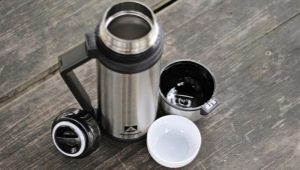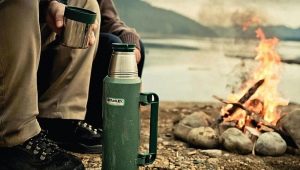Thermoses for food: varieties, rules for selection and operation
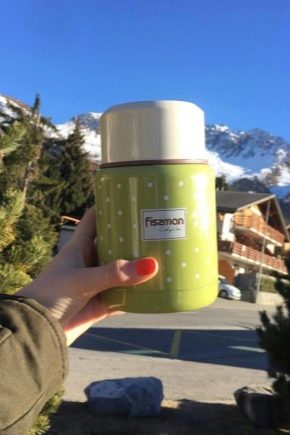
Tourists and geologists, truckers and many other people have to use thermoses. Even in a big city, this device is very important for constantly busy people. Therefore, you should know what it is, what types it happens and how it works.
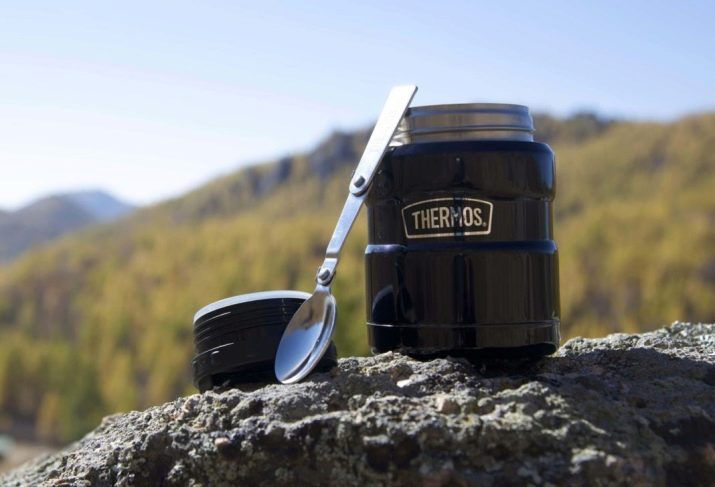
Peculiarities
The modern thermos for hot food is physically designed in exactly the same way as the very first samples of these devices. The soup version differs only in the presence of a double lid. The first level closes the neck, preventing the products inside from pouring out or getting enough sleep. At the second level, carving is provided. This design eliminates the contamination of bags, packages, backpacks with various foods.
The second lid is often used as a cup - and it turns out extremely convenient. Thermoses for long-term storage of food differ from conventional food models in that they can keep food at the required temperature for more than 48 hours.. Of course, for lunch at work, this is not necessary. But in tourist and expeditionary practice, such thermoses will be very attractive. Excellent impact resistance and mechanical strength are necessarily provided, which is achieved by using a special alloy.
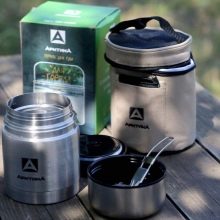
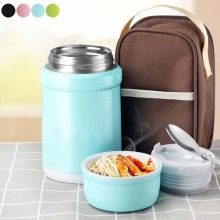
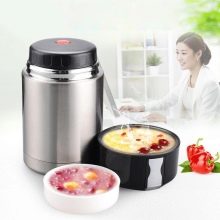
Kinds
The thermos with a wide mouth makes it as convenient as possible to put food in and take it out. In most cases, the outlet cross section is the same as the bulb cross section. Attention: models with a narrow drain are more suitable not for solid food, but for drinks. Modifications for soup, as well as for second courses, are formed by placing the flask in a special cylinder. Vacuum and twin walls provide the most complete heat retention.
The inner compartment is made of glass or various metals. The type of flask determines which lid will be used in a particular case. Glass models are locked with "plugs", and metal ones are equipped with especially reliable screw caps. Some versions are equipped with two or more containers for first courses and other food. In an office or industrial environment very good results are shown by an electric thermos heated from a socket.

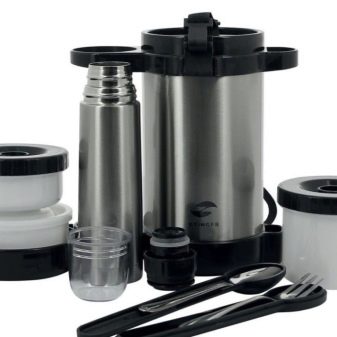
Even if, due to a busy work schedule or unpredictable events, the dishes get cold, it will be possible to guarantee a comfortable temperature for the products. Such lunchboxes will also help to refuse fast food and sandwiches.
It is not necessary to use plug-in versions. For people who are often forced to drive frequently during working hours, thermoses connected to the cigarette lighter are best suited. The universal type is the same as wide-mouth cookware.
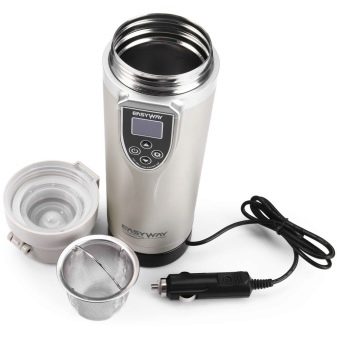

However, the universality of application is not always justified. When such a product is opened, the dishes will heat up or cool down too quickly. Purely liquid models with a pump-action cap also deserve attention. They are quite heavy and therefore not suitable for carrying in backpacks or bags. But for a trip on various modes of transport, a pump-action thermos is ideal.
The sudkovy option is used only occasionally. Such devices contain 3 smaller containers, the volume of which is 0.4-0.7 liters (depending on the design features). There are similar models made of special food-grade plastic. She handles high temperatures very well. Even with a sharp cooling, this substance retains its practical qualities.
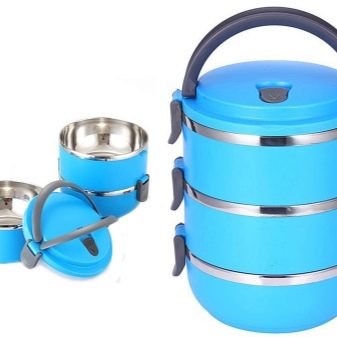
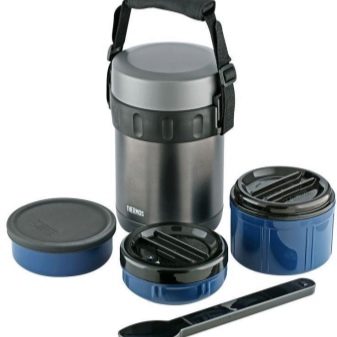
You can also look at flat models that look like plates. In some cases, they are more practical than conventional "cylinders". Such flattened thermal containers are great for keeping food hot on a long trip or on a long walk.
The main thing is that storage does not last more than 6 hours. Washing is possible even in simple dishwashers.
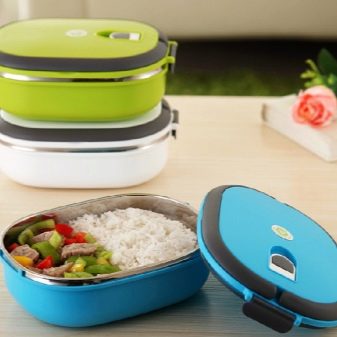
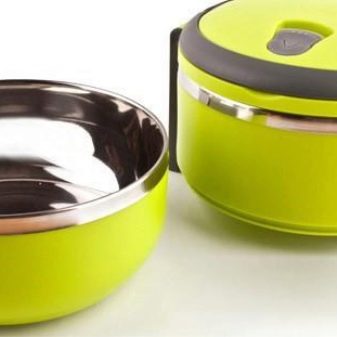
Flat thermoses are not so small. Yes, popular models Mayer and Boch, Bradex Bento hold 1.5 liters of food. But for those who can’t choose a suitable device for a long time, you need to familiarize yourself with “bag”-type thermoses - they can hold a lot of food and are suitable for multi-day trips. And the reproduction of the design of an ordinary bag is also quite pleasant - this makes the transportation of dishes more comfortable.


But the classification of thermoses can be made not only by size, features of the device and the main task being solved. The geometry of a particular product also plays an important role. The "bullet" type, that is, an elongated cylinder, has become widespread. This design is small in size and easy to use. Carrying the "bullet" is easy, however, due to the narrow neck, it is mainly filled with drinks.
The latest models of such thermoses do not have traffic jams. Valve screw-on lids reduce heat loss. Moreover, they will serve as an impromptu glass if no other container is at hand. The "universal" type is wider than the bullet, the neck also has a larger diameter. A valve may be provided inside, sometimes there are side handles; both of these elements make it easier to work with drinks.
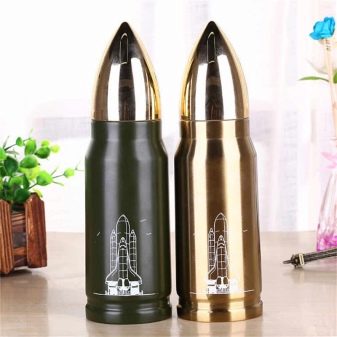
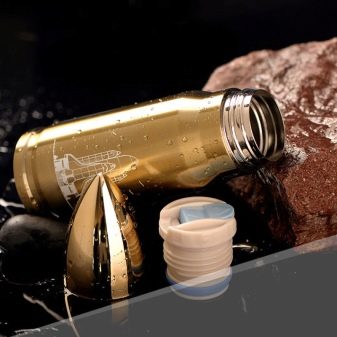
materials
Familiarity with the materials of thermoses is very important and should begin with the design of the case. The metal outer shell is very durable and highly impact resistant. But plastic also has its advantages - making a thermos body from it allows you to save and lighten the product. This option is not bad for use at work, at home and in summer cottages. But wearing plastic thermoses on hikes and taking them on long trips is not recommended.
The point is the lack of strength and stability of the plastic. This problem is common even with the best synthetic materials. Especially considering that Not all synthetics are equally good for making thermoses. It is necessary to take into account the properties of the flask.

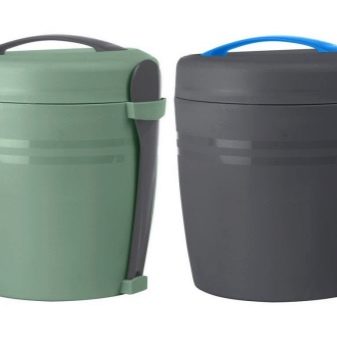
For decades food thermostats have been made from glass. This material:
- chemically inert (does not affect the quality of food and its taste);
- has a low thermal conductivity;
- easy to wash and clean mechanically.
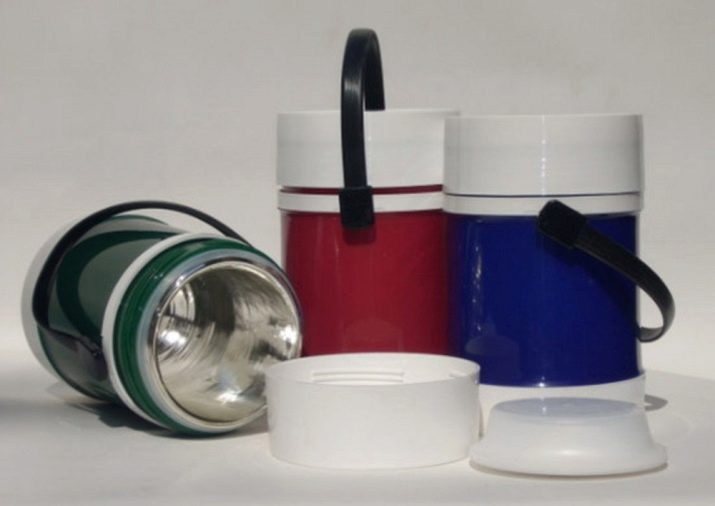
But we must remember about the fragility of glass, about the likelihood of its mechanical destruction in the event of a fall or strong impact.
Therefore, thermoses with glass flasks are chosen mainly for home or country use. In these cases, the vessel has to be moved infrequently; it is used mainly for storing food. As for plastic, it is valued primarily for its lightness.
Since plastic flasks are only damaged by very strong impact and pressure, a thermos with them can be used in almost any environment. But there is one caveat - odors are absorbed into the plastic very easily.Therefore, you will have to use a vessel strictly for one drink or product. Steel flasks are ideal for a wide variety of foods. Alloy of iron with carbon:
- does not pick up odors;
- excellent temperature retention;
- will survive even a very strong blow.
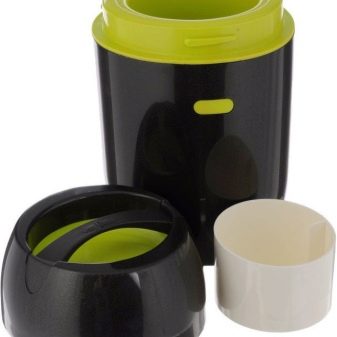
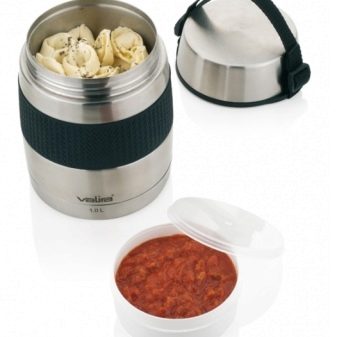
But keep in mind that a flask made of steel is heavier than one made of plastic. Important: it is advised to use not a simple ferrous metal, but a stainless alloy. Then it will be possible to safely use a thermos even on long-distance hiking trips. You need to choose the material strictly according to your needs. It is not recommended to trust anyone's opinions.
Manufacturer rating
- Thermos is great for soup. "Arctic 302-500". Its main parameters are:
- capacity - 0.5 l;
- production of the case and flask from first-class steel;
- retention of heat and cold for 7-8 hours;
- dry weight - 0.474 kg.
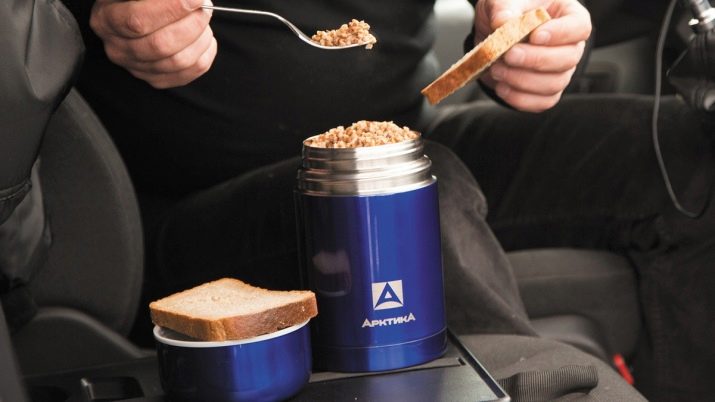
- Among the best models of thermoboxes for food is Regent Soup 93-TE-S-3-1000. Its volume is 1 liter. Both the outer shell and the flask are made of durable steel. Dry weight reaches 0.97 kg. It is not difficult to use such a product, a handle is provided, but there is also a small drawback - the product looks unnecessarily simple.
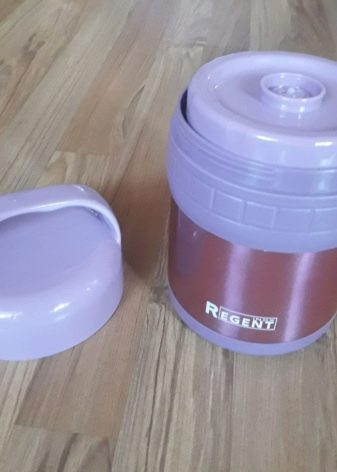

- Good for second courses "Arctic 301-750". This thermos contains 0.75 liters of food, all parts are made of steel. The model keeps the temperature longer than "302-500". The product is quite comfortable and looks good from the outside.

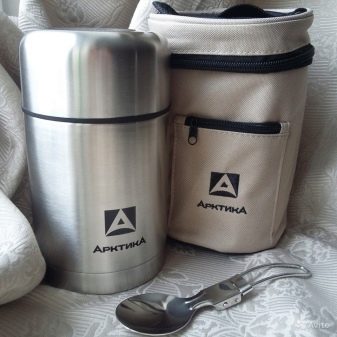
- For soups and second courses, the modification is equally intended Mayer & Boch 20690.

- It turns out to be a good alternative LaPlaya Food Container JMG 0,5L Petrol. This thermos holds 0.5 liters, its body is made of steel and plastic. The dry weight of the product is 0.32 kg. Heat retention guaranteed for 6 hours.
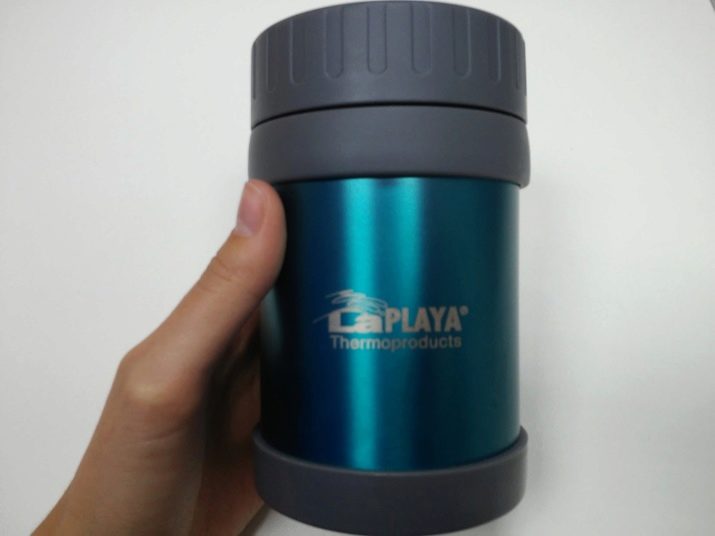
- Thermoses are recommended for food storage. Rosenberg 99504-Q - they are easy to wash, and extraneous aromas do not accumulate inside.

- The top of the best versions also includes a children's thermostat Thermos Funtainer Peace. Relatively small size and bright design make it quite suitable for schoolchildren. Sturdy steel construction is quite comfortable. The manufacturer guarantees that the food will remain warm for 4-5 hours. This is quite enough for meals at school, kindergarten or other similar places.
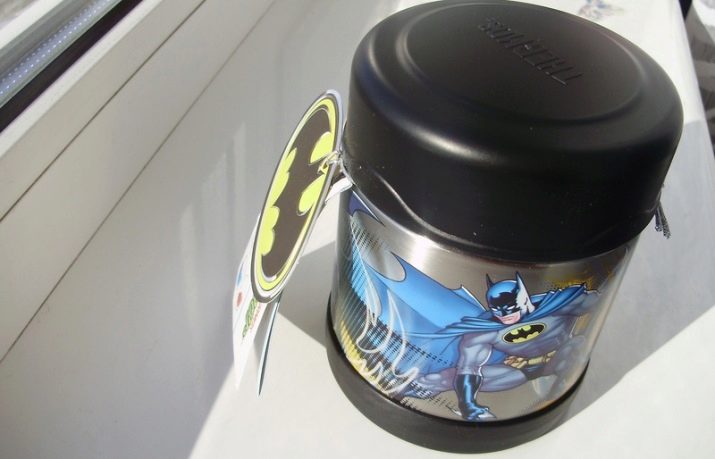
- If you need a 5 liter pump model, you should look at Bartscher 190135 26068. Both the handle and the lid are made of black plastic. A ring is integrated into the bottom. This allows you to rotate the thermos 360 degrees.

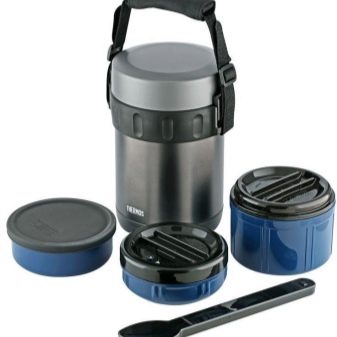
- Among thermos bags, it is recommended to choose the version Ezetil KC Camping. This is an oval product with a volume of up to 30 liters. The gray bag is made of PVC free material. The design of the structure is fully consistent with modern requirements. However, due to the significant value to pay for KC Camping it will take quite a substantial amount.
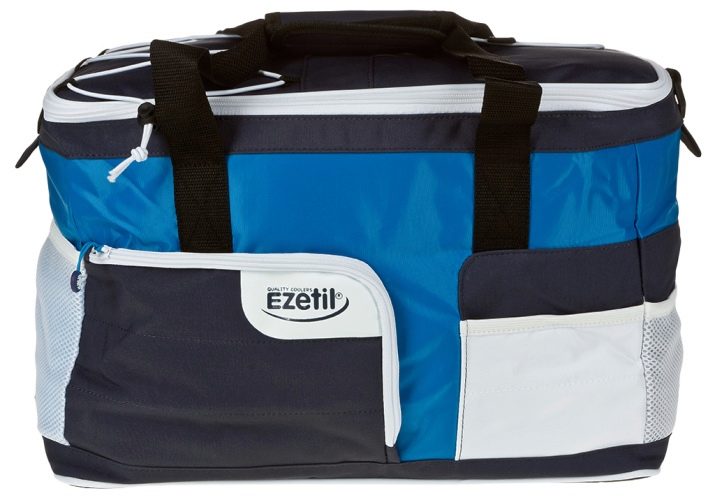
- As an alternative, you can consider a thermal bag Thermos Classic 48 Can Cooler. This product holds 33 liters of food and is made of durable plastic. The mass of the thermos in its original packaging is 0.515 kg.

- Among the miniature versions worthy of attention Thermos Element 5-Food Jar. This design is designed to retain both heat and cold. High temperature can be maintained for 7 hours, low temperature for 2 hours longer. Of course, these are ideal cases. The compact bag is equipped with an anti-slip coating.
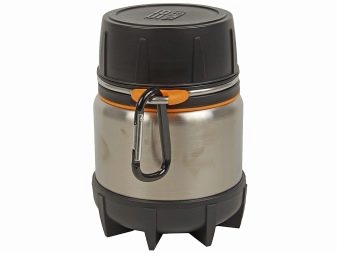
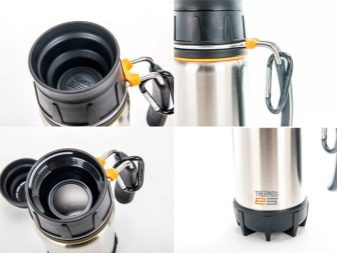
- A good alternative is Zojirushi. The volume of this thermos is 0.35 liters. Steel body guarantees heat retention up to 6 hours.

- Differs in convenience and functionality Amet Express. The thermos is divided into 2 compartments, so you can store both solid food and drinks at the same time. The design is thought out in such a way that it is possible to hold both hot and cold products. The main parameters are as follows:
- capacity - 1.2 l;
- handle equipment;
- case made of strong stainless steel;
- net weight - 1 kg;
- maintaining the initial temperature - up to 5 hours.


- Suitable for tea and coffee Mini PNF160. This thermos is convenient for hiking and long trips, including in the company. The capacity of the flask is 1.6 liters. However, the design is very successful, and the height is exactly 0.31 m. Important: mugs are included in the delivery set. It should be remembered that the Mini PNF160 also has a drawback - a glass bulb. It is very fragile, which to some extent pays off by maintaining heat for up to 12 hours under favorable conditions. This is quite enough not only for office work, but also for “one-day hiking trips”. For your information: the outer case is made of plastic with a matte finish, which is not subject to contamination. The glass flask has another advantage - it will not rattle, which is very good for hunting and fishing.
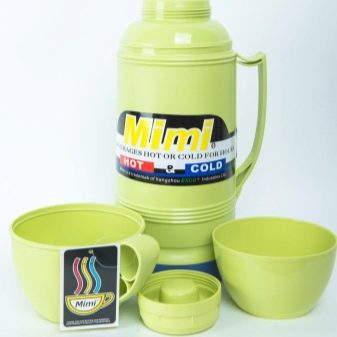
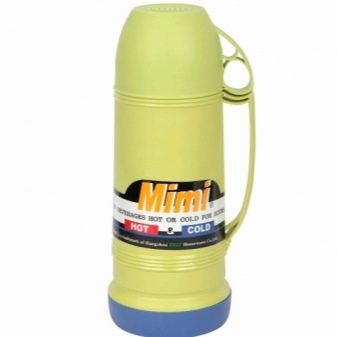
- Thermos Rocket Bottle - also an excellent thermos with a stainless steel shell. The designers were able to develop a reliable screw plug. Attachments for straps are provided, the length of the straps themselves is adjusted as needed. The thermos was equipped with a retractable handle. The manufacturer declares that drinks inside keep their temperature up to 48 hours, and testimonials confirm this statement.

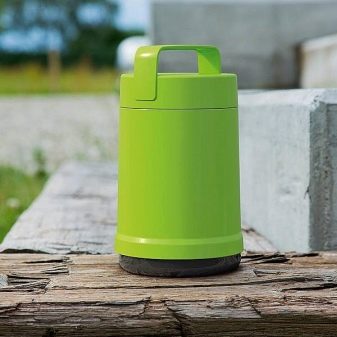
- deserves attention and Penguin BK-36. This thermos has been produced since 2001, and over the past time it has proven itself from the best side.The product can be taken even on long trips and multi-day trips. For your information: there are options with a capacity of 0.75 and 1 liter. A positive feature of the product can be called excellent temperature parameters, which is precisely the most important thing for thermoses. The thermos has an optimal design both for carrying in hands, in a backpack, and for transportation in a car. The creators fundamentally abandoned the use of seals. Instead, they tried to fit the pieces as closely as possible to each other. This solution will greatly simplify cleaning. Outwardly, the BK-36 looks attractive and even original.

How to choose?
When choosing a home thermos do not give preference to products of large volume (But they shouldn't be ignored either.) You need to carefully assess your needs. Carrying a very large and heavy vessel is simply inconvenient and impractical. This should be taken into account even for those who are going to carry food by car or motorcycle.
It is imperative to take into account the difference between metal and glass flasks. Metal products are better suited for hiking and for people who want to lead an active life. Glass structures are too fragile, in addition, they do not retain heat enough. Cooked food will cool down quickly. Plastic flasks are practically unsuitable, since they are even worse than those made of glass.
It is very important to evaluate the quality of the outer case. The best option is metal. Despite the increased severity, there is an important advantage: unlike glass and plastic, steel will not crack. Plastic products, even with extremely careful handling, cannot last more than 1 year.
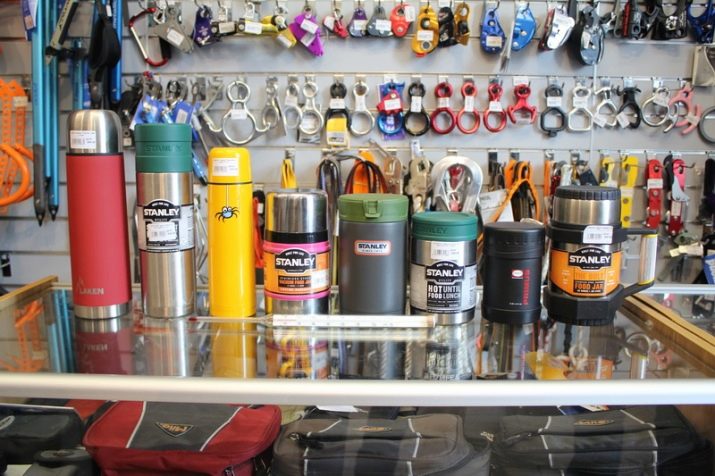
As for volume, should focus on certain people with their needs. That is why, by the way, a thermos is rarely suitable as a gift to an unfamiliar person.
But still, it is necessary to purchase very small, as well as very large models, only in exceptional cases. A small volume not only ends quickly, but also makes it difficult to retain heat. This turns out to be extremely inconvenient. Especially in cases where you will have to use a thermos frequently or unpredictably.
Another nuance - be sure to examine the device itself. He is held in his hands and examined from the inside, from the outside. Check how the lid is screwed on and off. It must be reliable and stable, even if the vessel is turned over and vigorously shaken. You should make sure that no foreign odors and tastes. And of course, you need to focus not so much on an affordable price as on consumer reviews.
As for thermoses with heating, everything is not easy here. Food heating is extremely rarely implemented at a high level. It's all about the great complexity of its proper organization in such a modest amount. But warming up drinks is usually done better.
Interestingly, some models are able to take energy not only from an outlet or from a cigarette lighter in a car, but also from a laptop.
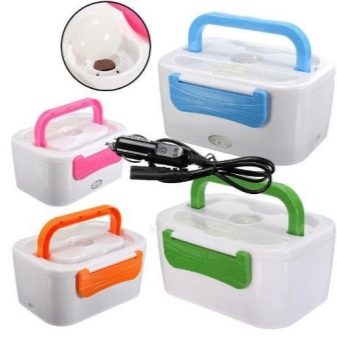
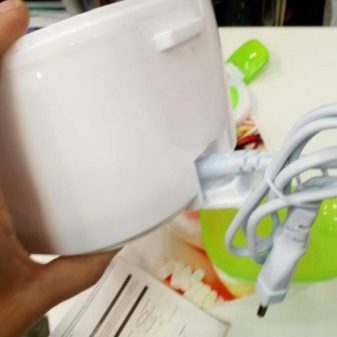
Tips for use and care
No matter how well the thermos is chosen, it is very important to use it strictly according to the rules. So, experts advise thoroughly rinsing the container after each use. If you delay too long, you will have to deal with dried food residues.
It is strictly forbidden to use thermoses with metal flasks for storing carbonated drinks, including champagne. Gas bubbles can cause serious damage to the product.
Sometimes a thermos has to be left unused for several months.Then before the first use of the vessel you need to hold warm water in it for 3-5 hours. This will avoid contamination of food with odor residues.
If the flask is made of plastic, it is not recommended to pour the soup all the way inside. There must still be some of the cork in the flask, as the plastic may be damaged.

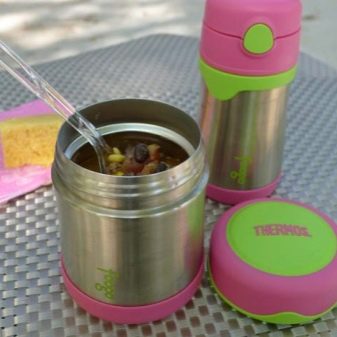
It is strictly forbidden to wash and clean the thermos:
- solvents;
- bleaches;
- abrasive mixtures.
Attempts at such cleaning will result in a significant reduction in service life. In addition, even the best metal products should be protected from drops and bumps, simply because the extra risk is not needed. Important: the very first time the thermos is thoroughly washed, and only then used. All non-aggressive household and branded products are used for washing.
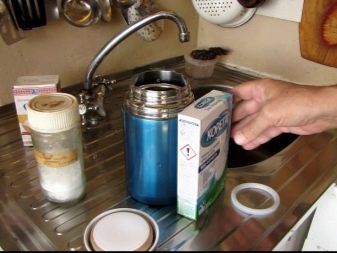

The cork or lid must be locked as carefully as possible, otherwise the contents will pour out and spill out. In the interval between uses, the thermos is kept open. This allows you to either completely avoid problems with foreign odors, or greatly facilitate the fight against them. Hot water is poured into a thermos with a glass flask, holding the vessel itself at arm's length. It is strictly forbidden to look inside!
Preheating of the flask in microwave ovens, ovens and other sources is unacceptable. In general, you should use a thermos strictly for moving and storing food, and not for cooking or heating. Shaking the contents of glass containers is undesirable. You should also not store sharp, cutting and other hard objects there. Regardless of the material from which the thermos and flask are made, you can not drink directly from it - you can get burned.
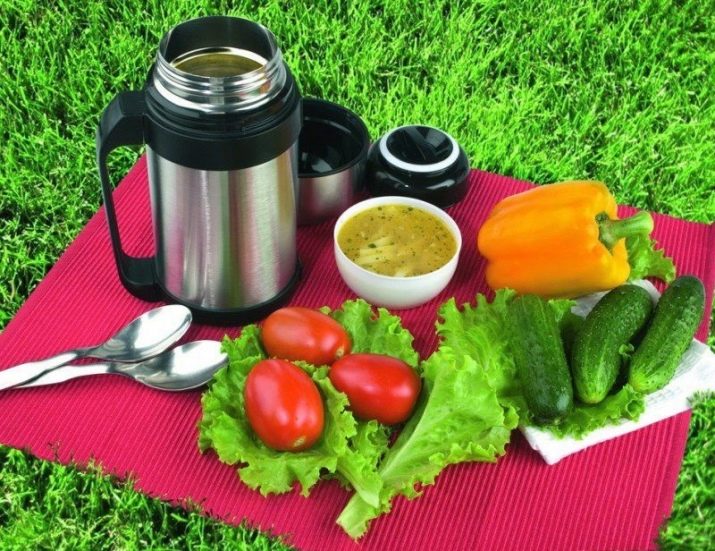
The vessel must be transported strictly vertically - This is the most reliable and practical position.Vertical placement is especially important for a glass thermos. After pouring out hot drinks, you need to wait a while before washing the container. As for filling, it is best to use exactly the amount that does not interfere with inserting the cork or screwing the cap on normally. Otherwise, the product will cool down or warm up too quickly.
You also need to know why a thermos can lose its basic properties. Most often this is due to a broken cork. Somewhere they simply save money in the production of the lid, do not follow the technology - that's why it is important to immediately choose a model with all rigor. But problems with corks and lids often arise through the fault of the consumers themselves, who make excessive efforts. Due to the high stress, cracks appear.
The leak test is very easy. Turn the thermos upside down and see if the liquid is leaking. Even a few drops indicate serious damage to it. But it is practically impossible to scratch the coating of a glass bulb even purposefully. If it is deformed, then it is definitely a manufacturing defect.
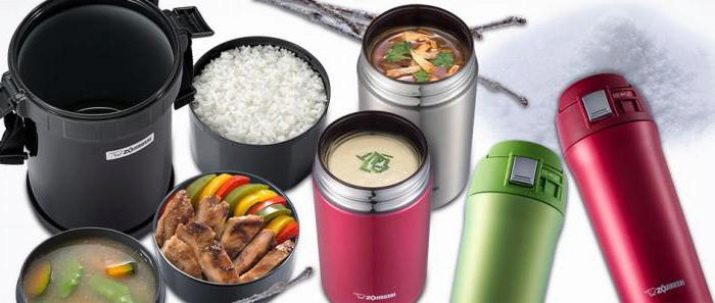
Reviews
Very good ratings are given to the company's products agness, especially models with a plastic container with a capacity of 750 ml. In this thermos, a strong body and relatively small dimensions are appreciated. The silicone insert and the carrying strap also attract people. A good alternative, adjusted for a smaller (0.5 l) volume, is Regent Soup 93-TE-S-2-500. This model is made of strong steel and can maintain the required temperature for up to 24 hours.

The vacuum thermos of the model is rated a little worse Stanley Adventure Vacuum Food Jar. This device is durable, but its aesthetic qualities will not satisfy all consumers.But in the descriptions, attention is drawn to the insignificant dry weight of the product and the compactness of the neck. In everyday life, such parameters are very convenient.
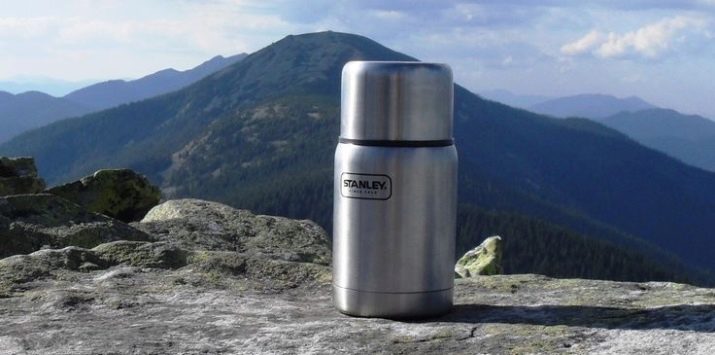
Regarding the insulated container "Mega" for 2.6 l, it is light and capacious food storage, easy to carry. However, it is noted that it does not hold heat well.
ZojirushiSZ-JB02BA consumers recommend for children attending school or sports training. The heat will be kept for 6 hours. In general, the device copes with its task.

But Esbit FJ1000ML causes conflicting opinions. In particular, there are complaints about the weakness of the sealing gum. The air valve in a cover simplifies its opening. But it can be clogged with dirt, and flushing is extremely difficult, since the lid cannot be disassembled. The device keeps the temperature well. It's nice to touch the body. However, one must take into account the reviews that say that the surface is easily covered with abrasions.

How to choose the right thermos, see the following video.






















